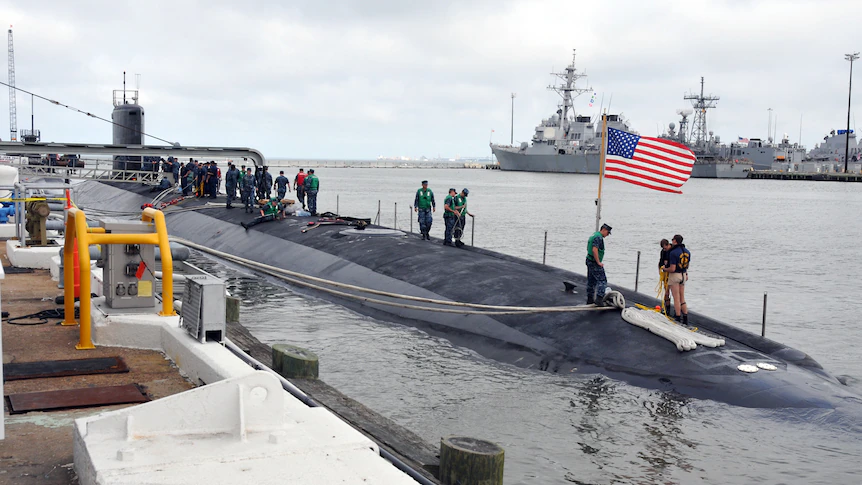ED: This video runs for 57 minutes … It deals mainly with army language, slang and abbreviations … I found the time to watch it all, most of you should find it interesting.
This pretty much condenses life into 79 seconds. If you don’t see yourself in this video at least once, you must be living on another planet…
ED: From my inbox thanks to Mike Kenavan
The Krakow Post
In a devastating escalation of the ongoing conflict, two Russian ballistic missiles struck the Ukrainian city of Poltava on Tuesday, marking one of the deadliest missile strikes since the war began. The missiles hit a military academy and a nearby hospital, causing widespread destruction and leaving a tragic toll in their wake. Several stories of the military academy collapsed, with shattered bricks and pools of blood visible at the scene a stark reminder of the human cost of this conflict. The attack occurred just as people were rushing to bomb shelters, hoping to find safety from the onslaught.
The aftermath of the strike has been harrowing. The death toll has climbed to 51, with 219 people reported wounded. Rescue teams continue to search through the rubble, fearing that up to 18 more people may still be buried beneath the debris. The missile strike also caused significant damage to the surrounding area, with ten apartment buildings reported damaged. The local community has rallied in support of the victims, with over 150 people donating blood to aid the injured in their recovery.
Ukrainian President Volodymyr Zelenskyy and Poltava’s regional governor Filip Pronin have both condemned the attack. President Zelenskyy has ordered an immediate investigation into the strike and reiterated his call for increased military aid from Ukraine’s allies. In a sombre address, Governor Pronin announced three days of mourning for the victims, describing the attack as a “great tragedy” for the region and the nation.
This missile strike is one of the deadliest since the onset of the war, further highlighting the brutal nature of the conflict. It draws grim comparisons to previous deadly attacks, such as the 2022 airstrike on a theatre in Mariupol and the missile strike on a train station in Kramatorsk. These incidents underscore a pattern of the Russian military targeting civilian areas, contributing to the heavy toll on innocent lives. The attack in Poltava serves as a painful reminder of the ongoing violence and the urgent need for a resolution to the conflict.
The Australian Government is taking a step forward in its commitment to strengthening the nation’s Defence industry workforce with the launch of the Schools Pathways Program: Open Competitive Grant Opportunity. This initiative, valued at over $11 million across two financial years (2024-25 and 2025-26), underscores the dedication to a future “made in Australia.”
The Schools Pathways Program is designed to raise awareness of career opportunities within the Defence industry and encourage students to engage in science, technology, engineering, and mathematics (STEM) subjects. By fostering interest in these critical fields, the program aims to build a robust pipeline of talent ready to meet the needs of Australia’s Defence sector.
Eligible organisations will be able to apply for funding ranging from $150,000 to $2,000,000 to deliver activities that align with the program’s goals. In addition to supporting student engagement, the program also offers professional development opportunities for teachers and provides resources for parents and carers to guide their children toward rewarding STEM careers.
Minister for Defence Industry and Capability Delivery, the Hon Pat Conroy MP, emphasized the importance of this initiative, stating, “This Government is committed to developing the defence industry skills we need for a future made in Australia.”
He added, “The launch of this grant opportunity is yet another example of delivering on the Defence Industry Development Strategy, supporting a resilient, competitive, and innovative Australian sovereign defence industrial base, and a future Defence industry workforce to support our national security.”
This latest grant opportunity builds on the $5.1 million already invested through inter-governmental agreements with South Australia and Western Australia over the financial years 2023-24 and 2025-26, further accelerating the Government’s investment in a highly skilled workforce.
Applications for the Schools Pathways Program grant will open in early September 2024. Detailed guidelines and additional information about the grant can be found at business.gov.au.
Reflecting on the broader impact of this initiative, Minister Conroy concluded, “The Schools Pathway program is a great example of how the Government is accelerating investment in a robust and highly skilled workforce, which will allow us to meet the needs of our Defence industry partners now and into the future.”
Photo: Army Maintenace Fitter – Defence Photo
Defence Media Release
Exercise Tarang Shakti 24 is being held at Air Force Station Jodhpur from 30 August to 13 September 2024. This marks the first time the Royal Australian Air Force (RAAF) has deployed combat aircraft to India for a multinational exercise. The RAAF has sent three EA-18G Growler aircraft from No. 6 Squadron, along with up to 120 personnel.
This exercise is a significant milestone for India as it is the inaugural edition of Exercise Tarang Shakti. The event has drawn participation from 11 nations and 18 observer nations, underscoring its global importance.
Chief of Air Force, Air Marshal Stephen Chappell, emphasized that Australia’s participation in Exercise Tarang Shakti highlights the nation’s commitment to supporting regional partners and fostering international cooperation to tackle shared security challenges. “India is a top-tier security partner for Australia, and through the Comprehensive Strategic Partnership between Australia and India, the Government is continuing to prioritize practical and tangible cooperation that directly contributes to Indo-Pacific stability,” Air Marshal Chappell stated.
He further noted that Australia’s involvement in international exercises like Tarang Shakti 24 showcases the RAAF’s advanced capabilities, ensuring rapid response and adaptability to emerging threats in the Indo-Pacific region. The exercise also offers Australian aviators the opportunity to enhance interoperability with foreign militaries, develop a mutual understanding of tactical operations, and strengthen international relations.
Australia and India have significantly bolstered their air defence cooperation in recent years, including hosting Indian Air Force Flankers at Exercise Pitch Black in 2018, 2022, and 2024. The RAAF also engages in various training and engagement activities with the Indian Navy’s P-8I Neptune surveillance aircraft. Moving forward, Australia is committed to deepening and expanding its defence cooperation with India, recognizing its crucial role in regional stability.
Summary of IPA Report
For years, Australia’s decision-makers have deluded themselves into believing that the CSIRO’s GenCost modelling is an accurate and reliable foundation for designing our nation’s energy future. This misplaced trust has led us astray, hiding the real costs of our energy choices. According to Scott Hargreaves, Executive Director of the Institute of Public Affairs (IPA), “We have been misled for too long on the true cost of the energy options on the table.”
The IPA’s newly released research report, “The Ruinous Cost of Free Energy: Why a System Built on Renewables Is the Most Expensive of All Options,” authored by University of Queensland Adjunct Professor Stephen Wilson, exposes the harsh realities of Australia’s future energy system. The report delivers a critical message: the federal government’s current energy system plan, coupled with its 2030 emissions targets, will result in a minimum four-fold increase in the average wholesale price of electricity. This sobering conclusion should make every Australian reconsider the direction we are headed.
The Flawed Approach of CSIRO’s GenCost Modelling
At the heart of the issue is the CSIRO’s Levelised Cost of Electricity (LCOE) methodology, which the federal government has heavily relied upon. However, the report argues that this approach is fundamentally flawed and misleading. The LCOE method only looks at the costs associated with generating electricity but neglects the broader, more critical aspect—the Total System Cost. According to the research, any meaningful decisions about our energy future should be based on Total System Cost, which considers all the expenses tied to delivering electricity to consumers.
Wilson’s report demonstrates that when a system is built on variable renewable energy sources like solar and wind, the Total System Cost can be at least twice as high as that of a system based on coal or nuclear baseload generation. This stark contrast is crucial for understanding why renewable energy is not the cheapest option, despite popular belief.
The High Cost of Renewables: A Price Too High to Pay
Australia once enjoyed some of the lowest electricity prices in the industrialised world, but those days are long gone. Now, we are among the nations with the highest electricity costs, a situation that has been exacerbated by decades of poor decision-making, rooted in flawed advice and ideological bias. “Decades of poor decision-making based on flawed and misleading advice and ideology is crushing the most productive sectors of our economy,” Hargreaves noted.
The report’s analysis of the Total System Cost method reveals three distinct wholesale energy cost zones:
- $50 per megawatt-hour (MWh) zone: This represents the total cost of the inherited coal-based generation system, which has been the backbone of Australia’s energy infrastructure.
- $100 per MWh zone: This reflects the total cost of a generation system led by reliable 24/7 options, such as coal and nuclear power.
- $200 per MWh zone: This represents the total cost of a generation system primarily based on variable renewable energy sources, like wind and solar.
The study shows that as the energy system shifts from the $50 cost zone of coal-based power to the $200 cost zone of renewables, the actual outcomes for consumers will likely result in even higher electricity prices. This shift is not merely an academic concern but a pressing economic reality that will hit Australian households and businesses hard.
Unseen Costs of Renewable Infrastructure
The report also highlights a critical oversight in the government and CSIRO’s current modelling: the failure to account for the enormous infrastructure costs associated with transitioning to a renewable energy system. The infrastructure required to support a renewable-dominated grid, including extensive upgrades to poles, wires, and storage facilities, represents a massive and often overlooked expense. When these costs are factored in, the case against a renewable-led energy future becomes even stronger.
According to Hargreaves, “Total System Cost calculations make clear that an energy system led by variable renewable generation is by far the most expensive approach government could take.”
The Need for a Reality Check on Australia’s Energy Future
Australia’s current energy system, primarily based on coal, represents the lowest cost option, according to the report. The next most affordable option would be a system built on new baseload power plants, whether they are coal-fired or nuclear. Yet, the government’s plans seem determined to phase out coal-fired generation, not on the basis of cost but due to emissions concerns.
While renewable energy sources like wind and solar are often touted as “free” because they do not require fuel, the reality is far more complex. The upfront investment required for renewable energy infrastructure is substantial, and the LCOE, which is used by the Australian Energy Market Operator (AEMO) relying on CSIRO’s GenCost model, fails to capture the true costs involved. This oversimplified calculation does not provide an accurate picture of the Total System Cost across the different types of generation needed to serve customer demand consistently.
The True Cost of Renewables: A System on the Brink
As the report underscores, a system that relies heavily on renewable energy will inevitably lead to much higher costs for consumers. The transition from a coal-based system at $50 per MWh to a renewable-based system at $200 per MWh will place a significant financial burden on Australians. Even if temporary price relief is provided through subsidies or other measures, the underlying economic issue remains unresolved.
In summary, the report by Adjunct Professor Stephen Wilson can be distilled into several key points:
- The energy system with the lowest Total System Cost is the one we currently have, based on coal-fired power.
- The LCOE of any generation type does not reflect the Total System Cost, making it an inadequate metric for decision-making.
- Renewable technologies can play a role in the energy mix, but their involvement should be limited to avoid escalating the Total System Cost.
Contrary to popular belief, coal-fired power plants are not destined to become obsolete after a set number of years. These plants can be periodically refurbished and continue to operate, making them a viable option for the foreseeable future. The benchmark for comparing costs should not be hypothetical new coal plants but the existing coal fleet, which remains the most cost-effective option.
Conclusion: A Call for Honest Assessment
Australia must face the facts. National security cannot be achieved without energy security, and a reliable, affordable energy system is crucial for the country’s future. Our leaders must urgently reassess the true costs of the energy alternatives and stop relying on the discredited GenCost modelling from CSIRO.
As the report concludes, the lowest cost system is the one we already have, and the next lowest cost system would be built on new baseload power plants, whether coal or nuclear. It’s time Australians were given the facts, and it’s time for our leaders to commission a thorough and honest analysis of the true costs of our energy options.
The Krakow Post
Germany’s political landscape has been thrown into disarray following the recent electoral success of the Alternative for Germany (AfD) party. Often labelled as the country’s leading “far-right” party, the AfD’s victories in state elections have sparked widespread controversy and concern about the future direction of German politics.
The AfD made history by winning a state election in Thuringia and came close to securing another victory in Saxony. This marks the first time since World War II that a “far-right” party has won a state election in Germany, a development that has sent shockwaves through the country’s political establishment. In Thuringia, the victory was led by Björn Höcke, a figure often associated with the more radical elements within the party. Meanwhile, in Saxony, the AfD finished just behind the centre-right Christian Democratic Union (CDU), highlighting the growing appeal of the AfD in Germany’s eastern regions.
The election results have placed immense pressure on Chancellor Olaf Scholz’s government. The governing coalition, consisting of the Social Democrats (SPD), Greens, and Free Democrats (FDP), received less than 15% of the vote combined in these state elections. This dismal performance reflects the growing discontent among voters with the national government’s handling of key issues such as inflation, economic stagnation, and internal divisions. Additionally, there is widespread frustration with the government’s immigration policies and its support for military aid to Ukraine, sentiments that the AfD has effectively capitalized on.
The conservative opposition, led by the CDU, faces significant challenges in forming governments without involving the AfD. Despite leading in national polls, the CDU must navigate complex coalition-building processes to exclude the AfD, a task that is becoming increasingly difficult as the AfD gains strength in key regions. In Thuringia, for example, even a coalition of the CDU, Scholz’s SPD, and the newly formed Sahra Wagenknecht Alliance would fall short of a majority. The AfD’s growing influence, particularly in eastern Germany, complicates the formation of governments that align with more traditional conservative or centrist values.
The implications of these election results are profound for Germany’s political future. With another state election in Brandenburg on September 22, the outcome could further weaken Scholz’s coalition and bolster the AfD’s momentum. The success of the AfD underscores the deep divisions and dissatisfaction within the country, driven by a range of factors including economic concerns, immigration, and scepticism towards the European Union.
Recent incidents of Islamist extremist violence have also fuelled public anxiety, leading to increased support for the AfD’s anti-immigration stance. The AfD’s ability to tap into these concerns, coupled with growing unease over inflation and economic management, has resonated with a significant portion of the electorate. Many Germans are turning towards policies that advocate for less government spending and tighter control over the nation’s finances, seeing these as necessary measures to protect Germany’s economic stability.
The media frequently describes the AfD as a “far-right” party, a label that is largely based on its controversial policies. The AfD strongly opposes illegal immigration, particularly from Muslim-majority countries, and advocates for stricter border controls. However, the party also supports moderate legal immigration based on qualitative criteria, where there is irrefutable demand that cannot be met by domestic resources or EU immigration.
The AfD is also known for its Euroscepticism, with the party being critical of the European Union and even calling for Germany to leave the Eurozone. This stance reflects a broader nationalist agenda that emphasizes traditional German culture and values, a message that resonates with voters who feel that these are under threat from globalization and liberal policies. Additionally, the AfD supports welfare policies that prioritize native Germans over immigrants, a position often referred to as welfare chauvinism.
The Need for Far-Right Politics?
The rise of the AfD raises important questions about the need for far-right politics in Germany. For many, the AfD’s success is a troubling sign of growing intolerance and a retreat from the progressive values that have defined post-war Germany. Critics argue that the party’s nationalist and anti-immigration policies threaten social cohesion and undermine the country’s commitment to human rights and European integration.
However, supporters of the AfD argue that the party is simply responding to the legitimate concerns of ordinary Germans who feel abandoned by the mainstream parties. They point to the failures of the established political class to address issues such as immigration, economic inequality, and national sovereignty, which have left many voters feeling disillusioned and alienated.
The question of whether there is a need for far-right politics in Germany is ultimately a reflection of the broader tensions and uncertainties facing the country. As the AfD continues to gain ground, it is clear that the party is tapping into a deep well of dissatisfaction and frustration that cannot be easily dismissed. Whether this will lead to a fundamental realignment of German politics or merely a temporary surge remains to be seen, but one thing is certain: Germany’s political landscape is in turmoil, and the AfD’s recent electoral success is a clear indication of the challenges that lie ahead.
Three Australian Navy officers, newly graduated from the UK’s Royal Navy nuclear reactor course, have been swiftly deployed to serve on British Astute-class attack submarines. This marks a significant step forward in Australia’s journey toward developing its own nuclear-powered submarine capabilities under the AUKUS agreement.
Admiral William Houston, who oversees the US Navy’s nuclear propulsion program, acknowledged the difficulties ahead in meeting the ambitious production goals to supply Australia with between three and five Virginia-class nuclear submarines. “It’s going to be challenging, but we’re committed to making it happen,” he said, emphasizing that the US is on track, with plans to hire 40,000 workers and invest over $10 billion in the submarine industrial base by 2032.
Speaking at HMAS Stirling near Perth, alongside Australian Submarine Agency Director-General Vice Admiral Jonathan Mead and Royal Navy Second Sea Lord Vice Admiral Martin Connell, Admiral Houston assured that the US is fully dedicated to delivering the submarines to Australia. He highlighted that this transfer is conditional on Australia’s readiness to maintain them and adhere to safety and stewardship standards.
The gathering of submarine chiefs coincided with a milestone: the Virginia-class submarine USS Hawaii underwent maintenance at HMAS Stirling, marking the first time such work has been performed outside US territory. Over 30 Australian Navy personnel have been embedded with their US counterparts since January on the submarine tender USS Emory S. Land, contributing to this maintenance effort.
Vice Admiral Mead described the development as “unprecedented” and a crucial step toward ensuring that by 2027, HMAS Stirling will be prepared to host a rotational presence of up to four US and one UK nuclear-powered submarines, in addition to Australia’s future fleet.
Despite these advancements, the US submarine production rate has dropped to just over one per year since 2022, far below the 2.33 per year needed to replace the vessels promised to Australia. Admiral Houston confirmed that achieving this production rate is a top priority, requiring a concerted effort across all levels of the US government. He noted the broad bipartisan support for the submarine build, stressing that AUKUS is a strategic imperative that strengthens all three nations involved.
Vice Admiral Mead also outlined plans to ramp up Australian submariner training in the US, aiming to have around 100 personnel, including 50 in the nuclear program, by 2025. However, he acknowledged the challenge of recruiting more Navy personnel and submariners to meet the growing demands.
Meanwhile, Vice Admiral Connell revealed that Australian personnel are now fully integrated into the design team for Australia’s future SSN-AUKUS submarines, which are expected to be delivered in the early 2040s. This collaboration signifies a deepening partnership among the AUKUS allies as they work towards a shared strategic goal.
On September 3, 2024, Australians mark the 82nd anniversary of the Battle for Australia, a pivotal series of events during World War II that forever shaped the nation’s history and identity. This day serves as a solemn reminder of the sacrifices made by the Australian military and civilians in defence of their homeland during one of the darkest periods of the 20th century.
The Historical Context
The Battle for Australia refers to a collection of military actions fought between 1942 and 1943, as Japan sought to expand its dominance in the Pacific. After the fall of Singapore in February 1942, Australia found itself directly threatened by Japanese forces. The bombing of Darwin on February 19, 1942, marked the first time the Australian mainland had been attacked by a foreign power, shattering any sense of invulnerability.
The threat was not limited to aerial assaults. Japanese submarines patrolled the Australian coastline, launching attacks on Sydney and Newcastle, while Japanese forces advanced through Southeast Asia and the Pacific, inching closer to Australia’s shores. The fear of invasion loomed large over the nation.
The Campaigns That Defined the Battle
The Battle for Australia encompasses several key engagements, both on Australian soil and in the broader Pacific theatre. Among these, the Kokoda Track campaign stands out as a defining moment. Fought in the rugged mountains of Papua New Guinea, Australian soldiers, many of them young and inexperienced, faced overwhelming odds against seasoned Japanese troops. Their tenacity and courage under brutal conditions became emblematic of the Australian spirit.
Another crucial battle was the Battle of the Coral Sea in May 1942, often cited as the first major naval battle in which aircraft carriers engaged each other. This strategic victory halted the Japanese advance toward Port Moresby, which would have placed northern Australia within range of Japanese bombers.
The battles of Milne Bay and Buna-Gona, among others, also played critical roles in turning the tide against Japanese forces. These victories were hard-fought and costly, but they were essential in ensuring the safety of the Australian mainland and the eventual Allied victory in the Pacific.
The Impact on Australian Society
The Battle for Australia had a profound impact on Australian society. It marked a turning point in the nation’s relationship with the British Empire and its reliance on British military protection. As Australia faced the prospect of invasion, it turned increasingly towards the United States for military and economic support, setting the stage for a long-standing alliance that continues to this day.
The war effort also led to significant changes on the home front. With men enlisted in the military, women stepped into roles that were previously reserved for men, from working in factories to serving in auxiliary military units. The sense of national unity and purpose that emerged during this time would have lasting effects on Australia’s social fabric.
A Day of Remembrance
Today, the Battle for Australia Day serves as an occasion to honour the memory of those who served and sacrificed during this critical period in history. Commemorative events are held across the country, including ceremonies at war memorials, educational programs in schools, and tributes to veterans. The day is not only a time to reflect on the past but also a reminder of the resilience and determination that defines the Australian character.
As we remember the 82nd anniversary of the Battle for Australia, we are reminded of the cost of freedom and the enduring importance of standing united in the face of adversity. The legacy of those who fought in the Battle for Australia lives on in the values of courage, loyalty, and perseverance that continue to shape the nation today.
Lest We Forget
ED: The article you just read was a speech given our granddaughter, Ella Cave, a year 11 student, at her school’s memorial service on the 3rd September.
The Late Rear Admiral Guy Richmond Griffiths, AO, DSO, DSC (1 March 1923 – 5 March 2024), stands as a remarkable figure in the history of the Royal Australian Navy (RAN). His century-long life, marked by extraordinary bravery, leadership, and service, reflects the dedication and resilience of a man deeply committed to his country. Griffiths’ military career spanned pivotal moments in global history, including World War II, the Korean War, and the Vietnam War. Beyond his military achievements, Griffiths continued to serve his nation and fellow veterans well into his retirement. His passing at the age of 101 marks the end of an era, but his legacy endures as a testament to the enduring spirit of the Australian Navy.
Early Life and Naval Beginnings
Born on 1 March 1923 in Sydney, New South Wales, Guy Richmond Griffiths grew up in the Hunter Valley, a region known for its rich history and rugged landscapes. His early life was shaped by the values of duty and discipline, which would later define his military career. In 1937, at the age of 14, Griffiths entered the Royal Australian Naval College as a cadet midshipman, beginning a journey that would see him rise through the ranks of the RAN and earn distinction in multiple theatres of war.
World War II and the Sinking of HMS Repulse
Upon graduating from the Naval College, Griffiths was posted to the Royal Navy for further training. It was during this time that he joined the battle cruiser HMS Repulse, a ship that would play a tragic role in his early career. On 10 December 1941, HMS Repulse, alongside HMS Prince of Wales, was sunk by Japanese air attack off the coast of Malaya. The loss of these ships was a significant blow to the Allied forces in the Pacific, but Griffiths, then a young midshipman, survived the ordeal. The experience of the sinking, with its profound loss of life, would leave an indelible mark on him, shaping his resolve and commitment to service.
Following the sinking of Repulse, Griffiths continued to serve with distinction in the Royal Navy and later the Royal Australian Navy. He was promoted to lieutenant in 1944 and soon after was awarded the Distinguished Service Cross (DSC) in May 1945 for his gallantry, skill, and devotion to duty during the successful assault operations in the Lingayen Gulf, Luzon Island, while serving aboard HMS Shropshire. This recognition highlighted Griffiths’ courage and leadership during some of the most challenging naval battles of the war.
Post-War Service: Korean and Vietnam Wars
After World War II, Griffiths’ career continued to ascend as he took on more significant roles within the RAN. During the Korean War, he served as the Gunnery Officer on HMAS Sydney, contributing to the ship’s operations in the conflict. His expertise in naval warfare and leadership skills were further recognized when he was given command of the guided missile destroyer HMAS Hobart during the Vietnam War. Under his command, HMAS Hobart played a critical role in naval operations, demonstrating Griffiths’ tactical acumen and ability to lead in complex and dangerous situations.
One of the defining moments of his post-war career came in 1974 when Griffiths, then commander of HMAS Melbourne, was called upon to assist in relief operations following the devastation wrought by Cyclone Tracy in Darwin. The cyclone had caused widespread destruction, and Griffiths’ leadership in the relief efforts showcased his dedication to helping those in need, whether in war or peace.
Leadership Roles and Retirement
In 1976, Griffiths was promoted to rear admiral and appointed Chief of Naval Personnel, a role that placed him in charge of managing the careers and welfare of RAN personnel. His experience and deep understanding of the Navy made him well-suited for this position, where he influenced the development and support of the Navy’s human resources during a time of significant change.
In January 1979, Griffiths took up his final posting as the Flag Officer Naval Support Command. This role, which he held until his retirement in 1980, saw him overseeing the logistical and operational support for the entire Navy, ensuring that the RAN remained ready and capable of fulfilling its mission.
Post-Military Contributions and Legacy
Following his retirement from active service, Griffiths did not fade into the background. Instead, he continued to contribute to the Australian community and the welfare of his fellow veterans. From 1980 to 1983, he served as the personnel director of Wormald International, bringing his leadership skills to the corporate world. Simultaneously, he was deeply involved in veteran affairs, serving as the national president of the Australian Veterans and Defence Services Council from 1980 to 2004. In this role, Griffiths was a tireless advocate for the rights and recognition of veterans, ensuring that their sacrifices were not forgotten.
Conclusion
Rear Admiral Guy Richmond Griffiths passed away on 5 March 2024 at the age of 101, leaving behind a legacy of service, bravery, and leadership that spanned more than six decades. His life is a powerful reminder of the sacrifices made by those who serve in the armed forces and the enduring impact they have on their country. Griffiths’ story is not just one of military achievement, but also of a lifelong commitment to the principles of duty, honour, and service to others. His legacy will continue to inspire future generations of Australian naval officers and serve as a beacon of the values that define the Royal Australian Navy.









